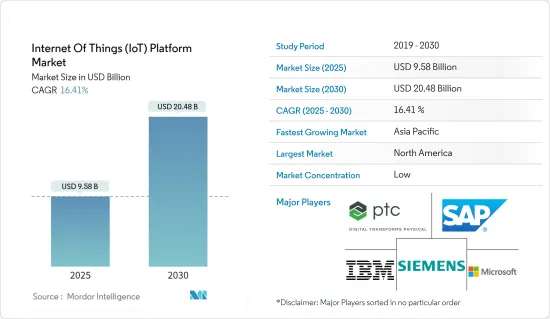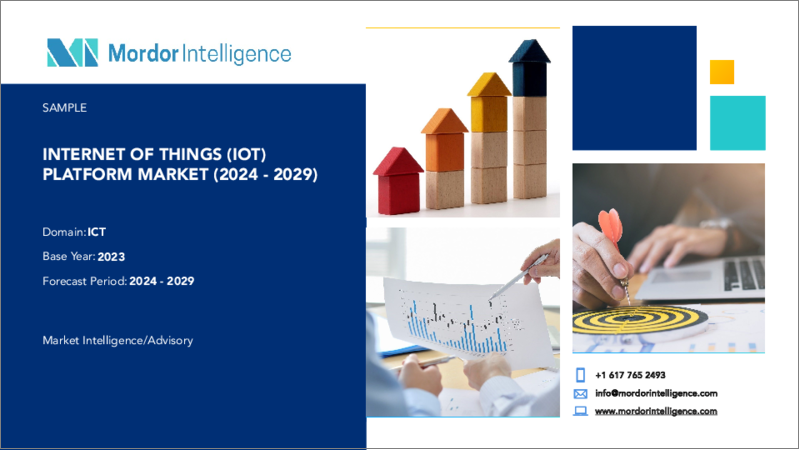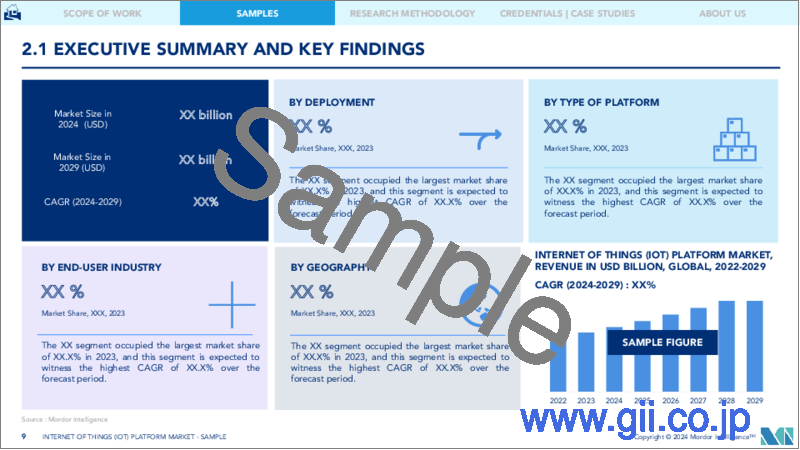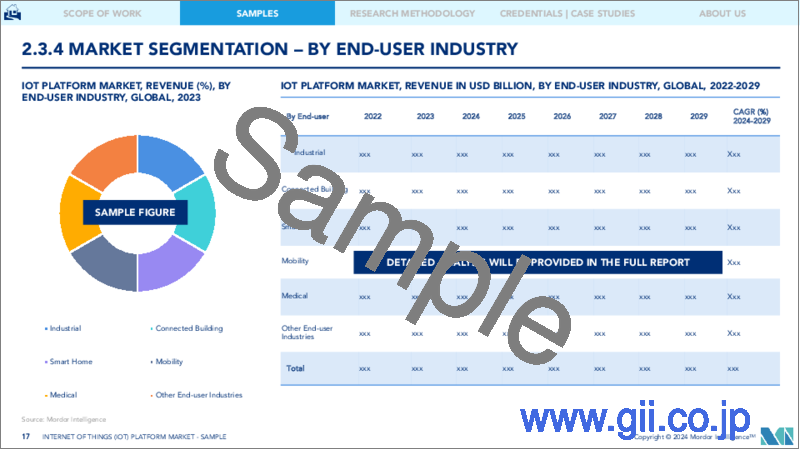|
|
市場調査レポート
商品コード
1630290
モノのインターネット(IoT)プラットフォーム:市場シェア分析、産業動向・統計、成長予測(2025年~2030年)Internet Of Things (IoT) Platform - Market Share Analysis, Industry Trends & Statistics, Growth Forecasts (2025 - 2030) |
||||||
カスタマイズ可能
適宜更新あり
|
|||||||
| モノのインターネット(IoT)プラットフォーム:市場シェア分析、産業動向・統計、成長予測(2025年~2030年) |
|
出版日: 2025年01月05日
発行: Mordor Intelligence
ページ情報: 英文 130 Pages
納期: 2~3営業日
|
全表示
- 概要
- 目次
モノのインターネット(IoT)プラットフォーム市場規模は、2025年に95億8,000万米ドルと予測され、予測期間(2025-2030年)のCAGRは16.41%で、2030年には204億8,000万米ドルに達すると予測されます。

IoTプラットフォームは、特にIoTアプリケーション向けに設計された開発ボードで構成されます。これらのプラットフォームは、IoTデバイスのさまざまな設計者がプロジェクトをインターネットに接続するのを支援する上で重要な役割を果たしています。IoTプラットフォームは、ラップトップ、モバイル、ウェアラブルフィットネスデバイス、産業用制御システム、自動車テレマティクスユニットなど、様々なIoT対応ハードウェアデバイスへの接続性を提供します。
主なハイライト
- IoTプラットフォームは、アプリケーションイネーブルメントプラットフォーム(AEP)とも呼ばれ、IoTデバイスとゲートウェイ、アプリケーションのレイヤーの間に位置するミドルウェアの一形態として定義されます。典型的なIoTプラットフォームは、プロセッシングユニット、メモリーユニット、コネクティビティモジュールを含む必須コンポーネントで構成されています。既存の市販センサーやアクチュエーターを簡単に統合することができます。
- IoTプラットフォームは、仮想世界と現実世界を接続し、データフローを管理しながらオブジェクト間の通信を可能にするIoTアーキテクチャの主要コンポーネントです。また、アプリケーション開発をサポートし、接続されたIoTデバイスの基本的な分析を提供します。
- IoTプラットフォームは、IoTアプリケーション専用に設計されており、携帯電話、ノートパソコン、産業用制御システム(ICS)、ウェアラブル・フィットネス機器、自動車用テレマティクス・ユニットなど、IoT対応ハードウェア機器の複数の設計者がプロジェクトをインターネットに接続するのを支援する上で重要な役割を果たす、さまざまな開発ボードで構成されています。プラットフォームの統合が動向となり、アクセスに必要なアプリケーションの数を最小限に抑えながら機能性を高めることに重点が置かれるようになったため、一貫したコラボレーションが市場での地位を広げています。例えば、前年、IoTキャリアの1NCEとアマゾン・ウェブ・サービス(AWS)は、1NCEのIoTプラットフォームの拡張を後押しするために協業し、そのクラウドネイティブなIoTサービスを世界中の顧客により近いところに分散させました。1NCEのユニークなソフトウェアはAWS上に構築されており、IoT開発者がプラグアンドプレイ機能で開発したソリューションにセルラーIoT接続を迅速に統合できます。
- 市場では、IoTエコシステムで接続されるデバイスの数が増加しています。このため、主に企業のデータセンターで大量のデータを転送、ダウンロード、アップロードする必要性が不可欠になっています。これらのセンターは、IoTデータ・リソースを管理するための専門知識、スピード、敏捷性の面で能力を強化するため、IoTプラットフォームを導入しています。接続されたIoTデバイスの増加によりデータ量が増大する中、ビッグデータも調査対象市場を補完すると期待される分野です。
- クラウド上のデータストレージの需要増加やデータ分析の需要拡大などの要因が、予測期間中にエンタープライズIoTプラットフォーム市場を押し上げると予想されます。データトラフィックの増加が、クラウドデータストレージの需要を支える主な要因となっています。世界中でIoTの導入が進むにつれ、デバイス間の接続性も高まっています。そのため、膨大なデータが蓄積されています。
- パンデミック(世界的大流行)の中で接触を最小限に抑える取り組みが強化され、ヘルスケア機関はPPEの保存に役立つIoTソリューションの導入を進めています。米国の5つの病院が、遠隔で監視・調整できるメドトロニックの世界初の人工呼吸器のテストに飛びついた。COVID-19に対応して開発されたメドトロニクスの人工呼吸器は、医師がどこからでもラップトップコンピュータ経由で人工呼吸器を遠隔監視・調整できるようにすることで、病院でのPPE使用の削減に貢献しています。マイクロソフトが昨年以前に発表したIoT Signalsレポートによると、COVID-19は組織とそのIoT戦略に予期せぬ利益をもたらし、調査対象となった業界専門家の44%近くが、COVID-19の大流行の結果としてIoT投資を加速させると予想しています。
モノのインターネット(IoT)プラットフォーム市場動向
医療エンドユーザー産業が大きな成長を遂げる見込み
- BICS SA/NVによると、コネクテッド医療機器はIoT技術全体の40%を占めると予想され、導入が容易なモニタリングやレポート作成機能によって患者体験を向上させ、業界を変革します。
- 世界のヘルスケア従事者の不足は、業界にとって重大な懸念事項です。米国だけでも、今後3年間で12万4,000人の医師が不足すると予測されています。アジアやアフリカで予想される不足数よりは少ないが、それでも重大な不足を意味します。この要因は、医療施設のアップグレードとヘルスケア分野の急成長の必要性を示しており、これが市場をさらに牽引する可能性があります。先進的でコネクテッドな医療機器は、需要が高まる可能性が高いです。
- IoTを含む生活習慣病管理アプリケーションはまだ初期段階にあり、コストがかかります。一般消費者は一般に、こうしたサービスを体験する必要があります。これは、そうした消費者層にサービスを提供するベンダーにとってチャンスとなります。
- 病院ほど慎重な対応のタイミングが求められる業界は数少ないです。生死の境をさまようような状況では、迅速な対応、適切な物資や薬の入手、どの医師がどこにいて、どこに行けば連絡が取れるかの把握などが頻繁に必要とされます。病院スタッフはIoTの活用により、医療機器の所在、備品の数量、同僚の所在をリアルタイムで把握できるようになった。病院内の感染症は回避され、常に高度な衛生状態を維持できます。
- 例えば、オレア・センサー・ネットワークスは前年のCESで、オレアの非接触・遠隔バイタルサイン・モニタリングの次世代システム「OleaSense」をベースにした「OSNデジタルヘルス・プラットフォーム」を発表しました。IoT製品開発や先端研究のためのデジタルヘルス開発プラットフォームは、OleaのAI信号処理とピーク検出アルゴリズムを使用してリアルタイムデータを処理し、心臓、呼吸、心拍変動などのバイタル統計を抽出します。
- エリクソンのレポートによると、2028年末までにセルラーIoT接続の60%近くがブロードバンド接続になると予想され、4Gが大半を接続します。5G新無線(NR)が既存の電波と新しい電波の両方で実装されるにつれて、スループット・データ・レートは大幅に上昇します。IoTアプリケーションのイノベーションを促進するために、実現可能な技術はヘルスケアセクターにとって不可欠なニーズです。IoTベースのヘルスケアシステムの実装は、病院、リハビリセンター、コミュニティ、家庭から収集されたビッグデータに基づいています。収集されたデータはリアルタイムで更新され、データトランザクションは接続されたモノの間で同時に発生する可能性があります。情報はサーバーに保存できます。
北米が大きな市場シェアを占める見込み
- GSMA Intelligenceによると、今後3年間に北米全体で54億のモノのインターネット(IoT)接続が行われると予想されています。北米では28億件のモノのインターネット接続があった。業務効率を促進し、競争力を高めるために、IoTの導入は組織によって推進されるが、この地域では、IoTの導入はコスト削減の欲求によって推進されます。Ovumの調査によると、アメリカの企業はコスト削減のためにIoTを頻繁に利用しています。
- IoTは米国で急成長している産業です。米国の近代的な製造施設は、より高品質な製品をより低コストで生産するための新技術やイノベーションに依存しています。コンシューマー・テクノロジー協会によると、前年度以前の米国におけるコネクテッド・デバイスの出荷台数は7億9,100万台だった。
- IoT技術は、特に米国のような先進国の製造業における労働力不足を克服しつつあります。このため、米国の連邦政府と民間部門は、中国や他の低労働コスト国に乗っ取られた米国の産業基盤を拡大するため、インダストリー4.0のIoT技術に投資しています。したがって、IoT技術は主にこの地域全体のスマート工場ソリューションの採用を促進する可能性があります。
- 顧客のダイナミックな要求を満たし、製品ポートフォリオを強化するため、企業は既存製品に新機能を組み込み、新製品を開発しています。例えば、消費者ブランドやインターネット・サービス・プロバイダー(ISP)のデジタル変革を加速させるモノのインターネット(IoT)プラットフォームのプレーヤーであるアイルラ・ネットワークスは、前年に先立ち、カナダ全土に500店舗以上を展開するカナディアン・タイヤ・コーポレーションのグループ企業であるカナディアン・タイヤが、同社のターンキーIoTファームウェアを採用し、世界的に利用可能な新しいスマートホーム製品のラインアップを提供すると発表しました。
- さらに昨年には、スマートシティやスマートビルディング向けの新しいモノのインターネット(IoT)ソリューションが、ロジャーズ・コミュニケーションズ(Rogers Communications)の企業向け部門であるロジャーズ・ビジネス(Rogers Business)から発表されました。ロジャースの多様なパートナーが提供するこれらの新しいソリューションは、水道、駐車場、交通、輸送、車両管理におけるレスポンスと効率を高め、ロジャースの現在のIoTポートフォリオを拡大しています。空気品質、セキュリティ、デジタル・サイネージ・システムの先端技術も、新しいスマート・ビル・ソリューションに含まれています。
モノのインターネット(IoT)プラットフォーム業界概要
モノのインターネット(IoT)プラットフォーム市場は、国内市場だけでなく国際市場でも多くのプレーヤーが活動しているため、細分化され競争が激しいです。市場には多くの技術的巨人が存在するため、市場は断片化されているように見えます。製品革新やM&Aなど、市場の主要企業はさまざまな戦略を採用しています。同市場の主要プレイヤーとしては、IBM Corporation、Microsoft Corporation、SAPなどが挙げられます。
- 2023年12月- エレベートは、大型移動機械業界におけるIoT(モノのインターネット)ソリューションの開発向上を支援するため、マイクロソフト社と提携しました。同社は、機械の健康状態を監視するIoTプラットフォーム「Elevat Machine Connect」を、ネットワークのエッジでクラウドコンピューティングを可能にするソフトウェア「Microsoft Azure Edge」と統合する(下記サイドバー参照)。これにより、Elevatのようなソリューションから収集されたデータの処理が高速化され、よりタイムリーな意思決定が可能になるため、計画外の機械のダウンタイムを最小限に抑えることができます。
- 2023年5月-IBMとSAP SEは、IBM WatsonテクノロジーをSAPソリューションに組み込み、AI主導の洞察と自動化を提供してイノベーションを加速し、SAPソリューション・ポートフォリオ全体で効率的かつ効果的なユーザー・エクスペリエンスを創出すると発表しました。
その他の特典:
- エクセル形式の市場予測(ME)シート
- 3ヶ月間のアナリストサポート
目次
第1章 イントロダクション
- 調査の前提条件と市場定義
- 調査範囲
第2章 調査手法
第3章 エグゼクティブサマリー
第4章 市場洞察
- 市場概要
- 業界の魅力度-ポーターのファイブフォース分析
- 新規参入業者の脅威
- 買い手の交渉力
- 供給企業の交渉力
- 代替品の脅威
- 競争企業間の敵対関係
第5章 市場力学
- 市場促進要因(自動化の進展、重要な資産となるビッグデータ分析、IoTへの投資拡大など)
- 市場の課題(市場の細分化、プラットフォームの拡張と管理のためのインフラ不足など)
- 主な使用事例とケーススタディ(サプライチェーンの可視化、スマート灌漑、サービス管理、製造パフォーマンスなど)
- 市場発展戦略(エコシステム開発、カスタマーサクセス、価格設定など)
- IoT市場情勢(現在のシナリオ、様々なカテゴリーにおける支出額、業界の成長に影響を与える主な要因、支出額別の主なエンドユーザー業界、主な発展など)
第6章 市場セグメンテーション
- 展開別
- オンプレミス
- クラウド/SaaS
- プラットフォームタイプ別
- アプリケーションイネーブルメント
- デバイス管理
- 高度分析
- クラウドストレージ/IaaS
- コネクティビティ
- エンドユーザー産業別
- 産業
- コネクテッド・ビル
- スマートホーム
- モビリティ
- 医療
- その他のエンドユーザーアプリケーション
- 地域別
- 北米
- 欧州
- アジア
- オーストラリア・ニュージーランド
- ラテンアメリカ
- 中東・アフリカ
第7章 競合情勢
- 企業プロファイル
- IBM Corporation
- Microsoft Corporation
- PTC Inc.
- SAP SE
- Siemens AG
- C3.ai
- Oracle Corporation
- GE Digital(General Electric Company)
- Hitachi Ltd
- Software AG
- ABB Ltd
- Amazon Web Services Inc.
- AVEVA Group PLC
- Alitzon Inc.
- Robert Bosch GmbH
第8章 投資分析
第9章 市場の将来
The Internet Of Things Platform Market size is estimated at USD 9.58 billion in 2025, and is expected to reach USD 20.48 billion by 2030, at a CAGR of 16.41% during the forecast period (2025-2030).

IoT platforms consist of development boards that are designed particularly for IoT applications. These platforms play an important role in helping various designers of IoT devices to connect their projects to the internet. IoT platform provides connectivity to various IoT-compatible hardware devices such as laptops, mobiles, wearable fitness devices, industrial control systems, automotive telematics units, etc.
Key Highlights
- IoT platforms, also called application enablement platforms or AEPs, are defined as a form of middleware that lies between the layers of IoT devices and gateways and applications, which it enables to build. A typical IoT platform consists of essential components that include a processing unit, a memory unit, and a connectivity module. They allow easy integration of existing commercial sensors and actuators.
- IoT platforms are the main component of IoT architecture that connects the virtual world and the real world and enables communication between objects while managing data flows. They also support application development and provide basic analytics for connected IoT devices.
- IoT platforms are designed specifically for IoT applications and consist of various development boards that play a crucial role in helping multiple designers of IoT-compatible hardware devices such as mobiles, laptops, industrial control systems (ICS), wearable fitness devices, and automotive telematics units to connect their project to the internet. Consistent collaborations are broadening market positions as consolidations of platforms have become the trend, with an emphasis on increasing functionality while minimizing the number of applications required to access them. For instance, the previous year, the IoT Carrier 1NCE and Amazon Web Services (AWS) collaborated to boost the expansion of the 1NCEs IoT platform, dispersing its cloud-native IoT offering closer to customers worldwide. Its unique software offering is built on AWS to enable quick integration of cellular IoT connectivity into solutions developed by IoT developers with plug-and-play functionalities.
- The market has been witnessing an increasing number of connected devices in an IoT ecosystem. Because of this, the need for transferring, downloading, and uploading large volumes of data, mostly in enterprise data centers, has become essential. These centers are deploying IoT platforms to enhance their capabilities in terms of expertise, speed, and agility to manage IoT data resources. As the amount of data grows owing to an increasing number of connected IoT devices, big data is another field that is expected to complement the studied market.
- Factors such as increasing demand for data storage over the cloud and growing demand for data analytics are expected to boost the market for enterprise IoT platforms over the forecast period. Increased data traffic has been the main underlying factor responsible for the demand for cloud data storage. With an increase in IoT adoption across the world, connectivity among devices is also growing. Hence, there is an accumulation of vast piles of data.
- The increased efforts to minimize contact amid the pandemic drive healthcare organizations to deploy IoT solutions that help preserve PPE. Five US hospitals have jumped to test Medtronic's first-of-its-kind ventilator that can be monitored and adjusted remotely. Medtronics' ventilator, which was created in response to COVID-19, is helping to reduce hospital use of PPE by allowing practitioners to remotely monitor and adjust the ventilator via a laptop computer from anywhere. According to Microsoft's IoT Signals report from prior to last year, COVID-19 resulted in unexpected benefits for organizations and their IoT strategies, with nearly 44% of all surveyed industry professionals expected to accelerate their IoT investments as a result of the COVID-19 pandemic.
Internet of Things (IoT) Platform Market Trends
Medical End-User Industry is Expected to Witness Significant Growth
- According to the BICS SA/NV, connected medical devices are expected to represent 40% of all IoT technology, transforming the industry by building an enhanced patient experience with easy-to-deploy monitoring and reporting proficiencies.
- A worldwide shortage of healthcare workers is a significant concern for the industry. In the United States alone, the shortage is projected at 124,000 physicians in the coming three years. Although it is lower than the anticipated shortages in Asia and Africa, it still signifies a crucial deficiency. This factor indicates a need for upgraded medical facilities and rapid growth in the healthcare sector, which may further drive the market. Advanced and connected medical equipment are more likely to experience demand.
- Lifestyle disease management applications involving IoT are still at a nascent stage and are costly. Ordinary consumers generally need to experience these services. This creates an opportunity for vendors serving such consumer segments.
- Only a few industries require such careful timing of responses as hospitals do. Life and death circumstances frequently need quick thinking, obtaining the appropriate supplies or medications, and knowing which doctor is accessible and where to reach him. Hospital staff can now track the whereabouts of medical equipment, the quantity of supplies, and the whereabouts of their coworkers in real-time, thanks to the use of IoT. Infections within the hospital can be avoided, and a consistently high degree of hygiene can be maintained.
- For instance, the previous year, Olea Sensor Networks announced the OSN Digital Health Platform at CES the same year, based on Olea's next-gen system for contactless and remote vital sign monitoring of OleaSense. The digital health development platform for IoT product development and advanced research processes real-time data using Olea's AI signal processing and peak detection algorithms, extracting vital statistics such as cardiac, respiration, and heart-rate variability.
- According to Ericsson report, Nearly 60% of cellular IoT connections are anticipated to be broadband connections by the end of 2028, with 4G connecting the vast majority. Throughput data rates will significantly rise as 5G New Radio (NR) is implemented in both existing and new airwaves. To promote innovations in IoT applications, enabling technologies is an essential need for the healthcare sector. The implementation of IoT-based healthcare systems is based on big data collected from hospitals, rehabilitation centers, communities, and homes. The gathered data updates in real-time, and the data transactions may happen simultaneously among the connected things. Information can be stored on the servers.
North America is Expected to Hold Significant Market Share
- According to GSMA Intelligence, it is anticipated that there will be 5.4 billion Internet of Things (IoT) connections overall in North America in the coming three years. In North America, there were 2.8 billion Internet of Things connections. In order to promote operational efficiency and boost competitiveness, IoT adoption is driven by organizations; however, in the area, IoT adoption is driven by the desire to save costs. An Ovum survey found that American businesses frequently used IoT to cut costs.
- IoT is a rapidly growing industry in the United States. Modern manufacturing facilities in the US rely on new technologies and innovations for producing higher quality products at an enhanced rate with lower costs. According to the Consumer Technology Association, based on prior to the previous year, the connected device shipments were 791 million units in the United States.
- IoT technologies are overcoming the labor shortage in the manufacturing sector, especially in developed countries like the United States. Due to this, the Federal Government and the private sector in the United States are investing in Industry 4.0 IoT technologies to increase the American industrial base, which China and other low-labor cost countries have taken over. Therefore, IoT technologies may mainly drive the adoption of smart factory solutions across the region.
- To meet the dynamic demands of the customers and enhance their product portfolio, the companies are incorporating new features in existing products and developing new products. For instance, prior to the previous year, Ayla Networks, a player in the Internet of Things (IoT) platforms that speed up digital transformation for consumer brands and Internet service providers (ISPs), announced that Canadian Tire, a member of the Canadian Tire Corporation group of companies with over 500 stores across Canada, selected its turnkey IoT firmware to power a new, globally available line of smart home products.
- Furthermore, in last year, New internet of Things (IoT) solutions for smart cities and smart buildings were introduced by Rogers Business, the part of Rogers Communications that focuses on businesses. These new solutions from diverse Rogers partners increase response and efficiency in water, parking, traffic, transit, and fleet management, expanding Rogers' current IoT portfolio. Advanced technology in air quality, security, and digital signage systems have also been included in new smart building solutions.
Internet of Things (IoT) Platform Industry Overview
The Internet of Things (IoT) Platform Market is fragmented and highly competitive, owing to the presence of many players in the market operating in the domestic as well as the international market. The market appears to be fragmented due to the presence of many technological giants in the market. Various strategies are being adopted by the major players in the market, such as product innovation and mergers and acquisitions. Some of the major players in the market are IBM Corporation, Microsoft Corporation, and SAP, among others.
- December 2023 - Elevate has partnered with Microsoft Corp. to assist in improving the development of IoT (Internet of Things) solutions in the heavy-duty mobile equipment industry. The company would integrate its Elevat Machine Connect, an IoT platform that monitors machine health, with Microsoft Azure Edge, a software that enables cloud computing at the edge of a network (see sidebar below). This provides faster processing of data collected from solutions like Elevat's, allowing more timely decision-making to occur so unplanned machine downtime can be minimized.
- May 2023 - IBM and SAP SE announced that IBM Watson technology would be embedded into SAP solutions to provide AI-driven insights and automation to accelerate innovation and create efficient and effective user experiences across the SAP solution portfolio.
Additional Benefits:
- The market estimate (ME) sheet in Excel format
- 3 months of analyst support
TABLE OF CONTENTS
1 INTRODUCTION
- 1.1 Study Assumptions and Market Definition
- 1.2 Scope of the Study
2 RESEARCH METHODOLOGY
3 EXECUTIVE SUMMARY
4 MARKET INSIGHTS
- 4.1 Market Overview
- 4.2 Industry Attractiveness - Porter's Five Forces Analysis
- 4.2.1 Threat of New Entrants
- 4.2.2 Bargaining Power of Buyers
- 4.2.3 Bargaining Power of Suppliers
- 4.2.4 Threat of Substitute Products
- 4.2.5 Intensity of Competitive Rivalry
5 MARKET DYNAMICS
- 5.1 Market Drivers (Growing Automation, Big Data Analytics becoming a Key Asset, Greater IoT Spending, etc.)
- 5.2 Market Challenges (Market Fragmentation, Lack of Infrastructure to Scale Platforms and Manage them, etc.)
- 5.3 Key Use-cases and Case Studies (Supply Chain Visibility, Smart Irrigation, Service Management, Manufacturing Performance, etc.)
- 5.4 Go-To-Market Strategies (Ecosystem Development, Customer Success, Pricing, etc.)
- 5.5 IoT Market Landscape (Current Scenario, Spending Across Various Categories, Key Factors Influencing the Growth of the Industry, Major End-user Industries by Spending, and Key Developments)
6 MARKET SEGMENTATION
- 6.1 By Deployment
- 6.1.1 On-premise
- 6.1.2 Cloud/Saas
- 6.2 By Type of Platform
- 6.2.1 Application Enablement
- 6.2.2 Device Management
- 6.2.3 Advanced Analytics
- 6.2.4 Cloud Storage/IaaS
- 6.2.5 Connectivity
- 6.3 By End-user Industry
- 6.3.1 Industrial
- 6.3.2 Connected Building
- 6.3.3 Smart Home
- 6.3.4 Mobility
- 6.3.5 Medical
- 6.3.6 Other End-user Applications
- 6.4 By Geography
- 6.4.1 North America
- 6.4.2 Europe
- 6.4.3 Asia
- 6.4.4 Australia and New Zealand
- 6.4.5 Latin America
- 6.4.6 Middle East and Africa
7 COMPETITIVE LANDSCAPE
- 7.1 Company Profiles
- 7.1.1 IBM Corporation
- 7.1.2 Microsoft Corporation
- 7.1.3 PTC Inc.
- 7.1.4 SAP SE
- 7.1.5 Siemens AG
- 7.1.6 C3.ai
- 7.1.7 Oracle Corporation
- 7.1.8 GE Digital (General Electric Company)
- 7.1.9 Hitachi Ltd
- 7.1.10 Software AG
- 7.1.11 ABB Ltd
- 7.1.12 Amazon Web Services Inc.
- 7.1.13 AVEVA Group PLC
- 7.1.14 Alitzon Inc.
- 7.1.15 Robert Bosch GmbH





